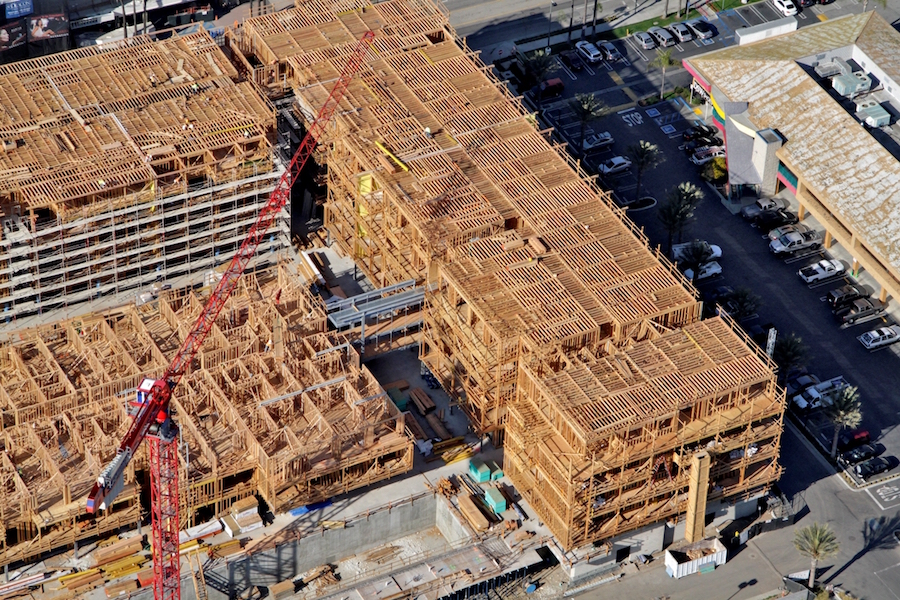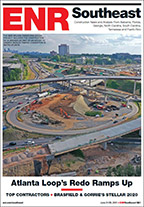New limits on the use of wood-frame construction imposed by the Atlanta suburb of Sandy Springs, Ga., are going against the trend toward wood frames, says a representative of the American Wood Council. Enacted in August, the changes in Sandy Springs’ local building code limit the use of wood framing to projects that meet two main criteria: building height of three stories or less—instead of the previous four-story maximum—and gross floor area of no more than 100,000 sq ft.
“We’ve not seen anything of this scale anywhere else in the country,” says Kenneth Bland, vice president for codes and regulations with American Wood Council (AWC). Calling it “outside of the trend” for the use of wood-frame construction nationwide, Bland adds, “We’ve seen no other attempt like this in any other jurisdiction.”
Sandy Springs commissioner John Paulson, an engineer, denied the code change was a ban, and instead described it as a relatively minor adjustment. “We’re not outlawing wood construction,” says Paulson. “Wood’s a viable construction material, as it has been for a zillion years.” Still, he says, the council acted to “make our buildings more durable.”
“It’s really a height limitation,” he says. “Instead of four stories, it’s three.”
However, the other main criteria, gross floor area, could likely contribute to limiting the use of wood-framed mid-rise structures. A review of wood-framed multifamily projects in the Dodge Data & Analytics database showed many such developments significantly exceed the 100,000-sq-ft maximum enacted by Sandy Springs.
As a result, competing building types could gain market share, a likelihood noted by Jimmy Cotty, executive director of the Georgia Ready Mixed Concrete Association. "Sandy Springs is leading the way in Georgia by prioritizing the long-term benefits of noncombustible construction,” Cotty says in a press statement.
The reasons for Sandy Springs’ action were not spelled out clearly, and didn’t specifically hinge upon safety concerns, says AWC.
“It’s a fairly big deal to the industry, because we really don’t understand the thought process that drove the council to make this decision,” Bland says. “It was never clear to us exactly what it was they were trying to accomplish by limiting the height and area of wood-framed buildings.”
One apparent cause for the height restriction, for example, was the city’s desire to promote more high-rise development over mid-rise options. “It had a lot to do with what kind of growth they want to see in the future,” says Cotty.
Commissioner Paulson called the height criteria a “secondary consideration,” but admitted “there is some thought in that regard.
“We’re a city that has many old apartment complexes, that are only one or two stories,” he adds. “The ability to have larger green spaces on some of these properties necessitates going taller.”
Additionally, the city commission’s ongoing effort to rewrite the local building code and zoning requirements—known as the Next 10 Plan—represents “a desire to put higher quality construction controls on development,” says Paulson.
Bland says Sandy Springs’ action leaves little room for consideration of emerging mass-timber structural framing systems for high-rise structures. Cross-laminated timber (CLT) panel systems have recently undergone, and passed, testing for flame-spread and fire-resistance, for instance.
“Sandy Springs said (they) don’t even want that kind of construction, even though it’s recognized for the sustainability attributes,” Bland says. “So they’ll allow a seven-story steel or concrete building, but they’re still prohibiting a seven-story CLT system, which would be more environmentally benign than steel or concrete.”
At this point, AWC is focused on preventing the restrictions on wood-framed construction from spreading to other Georgia jurisdictions. In the case of Sandy Springs, the state remains neutral on the matter, and defers to the city’s wishes. Other states, says Bland, have stricter requirements for making changes to building codes.
“We’re looking at opportunities that might be appropriate in Georgia to prevent this from occurring in other jurisdictions within the state,” he says. “We have found that once these decisions are made, it’s very difficult to have them reconsidered.”




Post a comment to this article
Report Abusive Comment